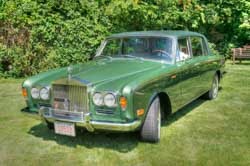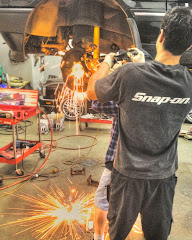When we diagnose electrical problems in cars the most common
finding is failed components. Light
bulbs come first, followed by motors of various sorts, and then switches and
finally sensors. We can see burnt out
bulbs but other component failures are often invisible, and are diagnosed by
test. A heater fan or fuel pump that
does not operate when powered up may look perfectly fine, but it does not
work. Switches and sensors are often the
same in that they fail invisibly.
Testing has become more complex in the past 20 years as cars
have moved from simple 12 volt off-of switching to smaller wires carrying
digital data of various sorts. Where we once tested circuits with simple test lights we
often need logic analyzers to read and interpret complex data streams. Automobile wiring has always been vulnerable
to corrosion, and digital circuits increase that vulnerability.
 |
| Nothing visible from outside, but pull the connector apart and you can see the corrosion (c) JE Robison |
Technicians have learned that most wiring problems are at
the ends – at terminals and junctions.
In between, there’s just the strand of wire, and what can go wrong with
that?
Sometimes, a lot can go wrong. Rodents can get into your car and chew into
wiring. Rodent chewed wires look like
this:
 |
| Chewed wiring in a BMW (C) JE Robison |
Mice can chew right through small gauge wiring leaving
inexplicable open circuits that can be very hard to find. A less common result is short circuits among
wires in a bundle. Shorts like that can
lead to electrical system meltdowns and even fires.
Another problem we see is invisible water damage. Many cars are built with wire harnesses running
along the floor. BMW and Land Rover are
two companies who do that. If those wire
harnesses have any punctures in the individual wire insulation those strands
will be vulnerable to corrosion from water on the floor, and after absorbing
water for a few months they can rot through the wire leaving an open circuit
hidden invisibly inside the insulation.
Problems like that can be very hard to track down.
The final problem we see with wiring is insulation
breakdown. Sometimes carmakers and their
suppliers make mistakes, and the insulation ends up breaking down. When that happens the wire insulation cracks
and falls off. That’s sometimes a real
disaster, particularly in the case of a multi wire harnesses in the engine bay.
The problem with insulation breakdown is that it’s often
fickle. For example, the problem may
only affect 12 gauge brown wire, or perhaps it’s all the 20 gauge wire in a
car. Some series of cars are vulnerable;
luckily most are fairly immune.
In this photo you can see a number of wires, but only one
has crumbling insulation.
 |
| Look closely at the brown wire, bottom right (c) JE Robison |
The moral of this story is that wire may look simple, but
the problems wire can create are far from simple to find and fix. We’ve learned through hard experience that a
sensor can test good, and the connector can be nice and clean, yet the signal
may still fail to arrive at the other end.
The more complex electrical system get the more common issues like this
are becoming. Electrical systems in cars
are more reliable for sure, but a modern car has hundreds of wires, as opposed
to dozens in the cars of yesterday, and that makes them inherently more
vulnerable.
Sometimes all it takes is one strand corroded in a 20 wire
harness, and if that wire carried a crank authorization signal you have a
stranded vehicle.
(c) 2017 John Elder Robison
John Elder Robison is the general manager of J E Robison Service Company, celebrating 30 years of independent Bentley, Rolls-Royce, BMW/MINI, Mercedes, and Land Rover restoration and repair in Springfield, Massachusetts. John is a longtime technical consultant to the car clubs, and he’s owned and restored many fine British and German motorcars. Find him online at www.robisonservice.com or in the real world at 413-785-1665
Reading this article will make you smarter, especially when it comes to car stuff. So it's good for you. But don't take that too far - printing and eating it will probably make you sick.

























No comments:
Post a Comment